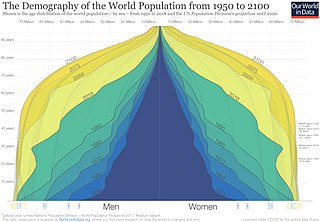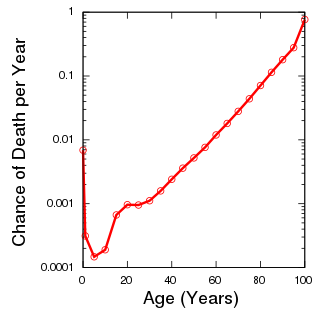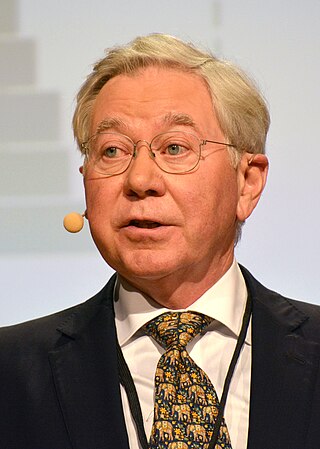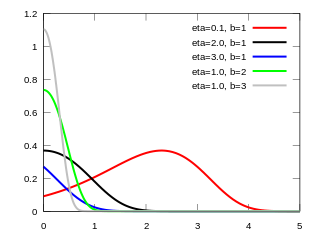
Human life expectancy is a statistical measure of the estimate of the average remaining years of life at a given age. The most commonly used measure is life expectancy at birth. This can be defined in two ways. Cohort LEB is the mean length of life of a birth cohort and can be computed only for cohorts born so long ago that all their members have died. Period LEB is the mean length of life of a hypothetical cohort assumed to be exposed, from birth through death, to the mortality rates observed at a given year. National LEB figures reported by national agencies and international organizations for human populations are estimates of period LEB.

Demography is the statistical study of human populations: their size, composition, and how they change through the interplay of fertility (births), mortality (deaths), and migration.

Longevity may refer to especially long-lived members of a population, whereas life expectancy is defined statistically as the average number of years remaining at a given age. For example, a population's life expectancy at birth is the same as the average age at death for all people born in the same year.
Maximum life span is a measure of the maximum amount of time one or more members of a population have been observed to survive between birth and death. The term can also denote an estimate of the maximum amount of time that a member of a given species could survive between birth and death, provided circumstances that are optimal to that member's longevity.
The Gompertz curve or Gompertz function is a type of mathematical model for a time series, named after Benjamin Gompertz (1779–1865). It is a sigmoid function which describes growth as being slowest at the start and end of a given time period. The right-side or future value asymptote of the function is approached much more gradually by the curve than the left-side or lower valued asymptote. This is in contrast to the simple logistic function in which both asymptotes are approached by the curve symmetrically. It is a special case of the generalised logistic function. The function was originally designed to describe human mortality, but since has been modified to be applied in biology, with regard to detailing populations.
Life history theory (LHT) is an analytical framework designed to study the diversity of life history strategies used by different organisms throughout the world, as well as the causes and results of the variation in their life cycles. It is a theory of biological evolution that seeks to explain aspects of organisms' anatomy and behavior by reference to the way that their life histories—including their reproductive development and behaviors, post-reproductive behaviors, and lifespan —have been shaped by natural selection. A life history strategy is the "age- and stage-specific patterns" and timing of events that make up an organism's life, such as birth, weaning, maturation, death, etc. These events, notably juvenile development, age of sexual maturity, first reproduction, number of offspring and level of parental investment, senescence and death, depend on the physical and ecological environment of the organism.
Stuart Jay Olshansky is a professor in the School of Public Health at the University of Illinois at Chicago concentrating on biodemography and gerontology and is co-founder and Chief Scientist at Lapetus Solutions, Inc.
The reliability theory of aging is an attempt to apply the principles of reliability theory to create a mathematical model of senescence. The theory was published in Russian by Leonid A. Gavrilov and Natalia S. Gavrilova as Biologiia prodolzhitelʹnosti zhizni in 1986, and in English translation as The Biology of Life Span: A Quantitative Approach in 1991.
The compensation law of mortality states that the relative differences in death rates between different populations of the same biological species decrease with age, because the higher initial death rates in disadvantaged populations are compensated by lower pace of mortality increase with age. The age at which this imaginary (extrapolated) convergence of mortality trajectories takes place is named the "species-specific life span". For human beings, this human species-specific life span is close to 95 years.

The Gompertz–Makeham law states that the human death rate is the sum of an age-dependent component, which increases exponentially with age and an age-independent component. In a protected environment where external causes of death are rare, the age-independent mortality component is often negligible. In this case the formula simplifies to a Gompertz law of mortality. In 1825, Benjamin Gompertz proposed an exponential increase in death rates with age.
Enquiry into the evolution of ageing, or aging, aims to explain why a detrimental process such as ageing would evolve, and why there is so much variability in the lifespans of organisms. The classical theories of evolution suggest that environmental factors, such as predation, accidents, disease, and/or starvation, ensure that most organisms living in natural settings will not live until old age, and so there will be very little pressure to conserve genetic changes that increase longevity. Natural selection will instead strongly favor genes which ensure early maturation and rapid reproduction, and the selection for genetic traits which promote molecular and cellular self-maintenance will decline with age for most organisms.
Following is a list of topics related to life extension:
Biodemography is the science dealing with the integration of biological theory and demography.

James W. Vaupel was an American scientist in the fields of aging research, biodemography, and formal demography. He was instrumental in developing and advancing the idea of the plasticity of longevity, and pioneered research on the heterogeneity of mortality risks and on the deceleration of death rates at the highest ages.

In probability and statistics, the Gompertz distribution is a continuous probability distribution, named after Benjamin Gompertz. The Gompertz distribution is often applied to describe the distribution of adult lifespans by demographers and actuaries. Related fields of science such as biology and gerontology also considered the Gompertz distribution for the analysis of survival. More recently, computer scientists have also started to model the failure rates of computer code by the Gompertz distribution. In Marketing Science, it has been used as an individual-level simulation for customer lifetime value modeling. In network theory, particularly the Erdős–Rényi model, the walk length of a random self-avoiding walk (SAW) is distributed according to the Gompertz distribution.

Negligible senescence is a term coined by biogerontologist Caleb Finch to denote organisms that do not exhibit evidence of biological aging (senescence), such as measurable reductions in their reproductive capability, measurable functional decline, or rising death rates with age. There are many species where scientists have seen no increase in mortality after maturity. This may mean that the lifespan of the organism is so long that researchers' subjects have not yet lived up to the time when a measure of the species' longevity can be made. Turtles, for example, were once thought to lack senescence, but more extensive observations have found evidence of decreasing fitness with age.

In gerontology, late-life mortality deceleration is the disputed theory that hazard rate increases at a decreasing rate in late life rather than increasing exponentially as in the Gompertz law.
William Matthew Makeham was an English actuary and mathematician.

The mutation accumulation theory of aging was first proposed by Peter Medawar in 1952 as an evolutionary explanation for biological aging and the associated decline in fitness that accompanies it. Medawar used the term 'senescence' to refer to this process. The theory explains that, in the case where harmful mutations are only expressed later in life, when reproduction has ceased and future survival is increasingly unlikely, then these mutations are likely to be unknowingly passed on to future generations. In this situation the force of natural selection will be weak, and so insufficient to consistently eliminate these mutations. Medawar posited that over time these mutations would accumulate due to genetic drift and lead to the evolution of what is now referred to as aging.
This timeline lists notable events in the history of research into senescence or biological aging, including the research and development of life extension methods, brain aging delay methods and rejuvenation.







